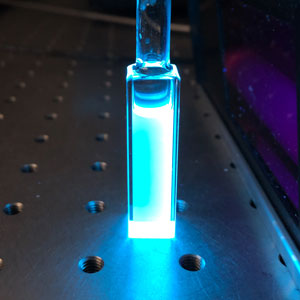Oct. 9, 2020 Research Highlight Chemistry
Computer models reliably predict light-emitting behavior of organic LED materials
A new understanding of the rules governing light emission in certain organic materials should lead to the development of improved devices
 Photograph showing light emission from a reverse intersystem crossing (RISC) material.© 2020 RIKEN Center for Emergent Matter Science
Photograph showing light emission from a reverse intersystem crossing (RISC) material.© 2020 RIKEN Center for Emergent Matter Science
Very bright yet highly energy-efficient organic light-emitting diodes (OLEDs) could be developed for a range of research, industrial and biomedical applications, thanks to a computational model developed by RIKEN researchers1. The model enables the reliable prediction and rational design of new materials with improved light-emission properties.
OLEDs are an emerging technology for both eco-friendly lighting sources and full-color, flat-panel displays because of their superior color quality, flexibility and wide viewing angle.
Organic materials that display a property called reverse intersystem crossing (RISC) have shown great promise as light-emitting materials for OLEDs. “In OLEDs, such materials theoretically allow an internal charge-to-photon conversion efficiency of 100%,” says Naoya Aizawa from the RIKEN Center for Emergent Matter Science, who co-led the current study.
However, although several RISC materials have been discovered (Fig. 1), a fundamental understanding of RISC behavior has been lacking, preventing the rational design of improved RISC materials.
 Naoya Aizawa and his co-workers have developed a computational model that reliably predicts reverse intersystem crossing in certain organic molecules, potentially enabling the design of new organic LED materials.© 2020 RIKEN
Naoya Aizawa and his co-workers have developed a computational model that reliably predicts reverse intersystem crossing in certain organic molecules, potentially enabling the design of new organic LED materials.© 2020 RIKEN
RISC-related light emission stems from the way electrons in organic materials transition between different excited states, under the influence of an electron property called spin. In the ground energy state, all the electrons in the material organize themselves into pairs with opposite spin. When excited, a single electron can jump up to a higher energy level—and can also flip its spin, so the material enters a ‘triplet state’. Only once the excited electron’s spin flips back to a singlet state—the process of RISC—can the electron shed energy in the form of light to drop back down to the ground state.
Aizawa and his colleagues have now shown computationally that RISC does not occur from the lowest energy excited triplet state, as previous models had assumed. Instead, it occurs from a higher-lying excited state. “This has been one of the open questions in the field, but it is hard to experimentally prove short-lived intermediate states,” Aizawa explains. “Identifying such states is one of the benefits of using a computational simulation.”
Using a model that calculated RISC based on higher energy excited states, the researchers could reliably predict the RISC behavior of a range of organic materials. “Our research was motivated by concerns about the cost and time required to synthesize and characterize organic materials,” Aizawa says. “Computationally predicting their properties may facilitate the discovery of new materials.”
The team’s next step will be to use their model to discover materials that display fast RISC on a time scale of nanoseconds. “This is an essential step to fabricating OLEDs with high brightness and long lifetime,” Aizawa comments.
Related contents
- Exciplex emission observed over much longer distances than previously thought possible
- New mechanism allows lower energy requirement for OLED displays
Reference
- 1. Aizawa, N., Harabuchi, Y., Maeda, S. & Pu, Y.-J. Kinetic prediction of reverse intersystem crossing in organic donor–acceptor molecules. Nature Communications 11 3909 (2020). doi: 10.1038/s41467-020-17777-2
